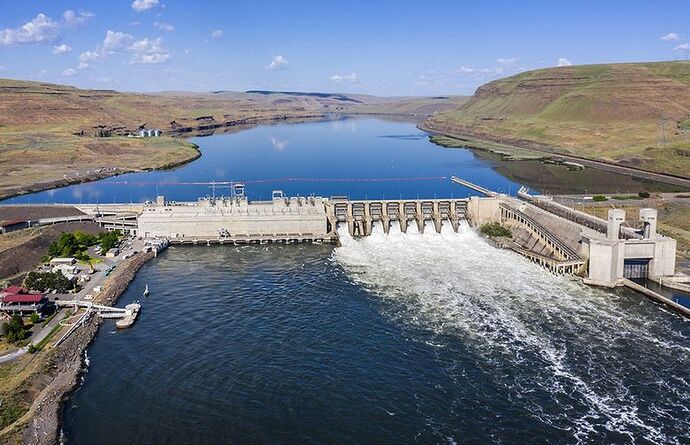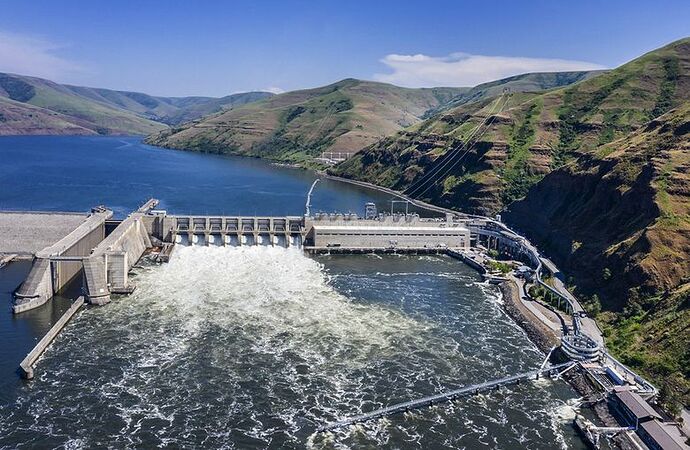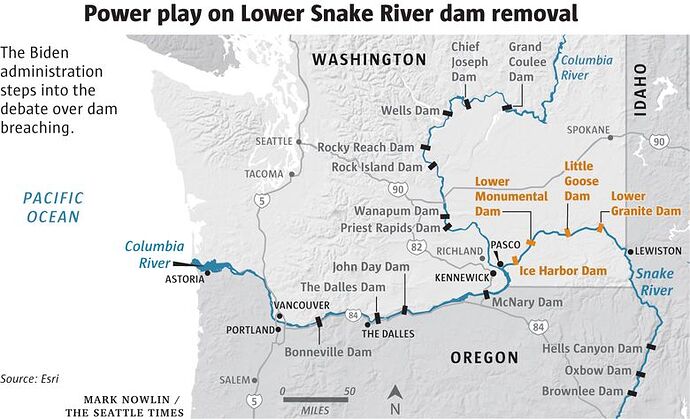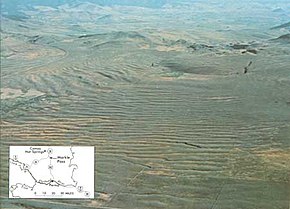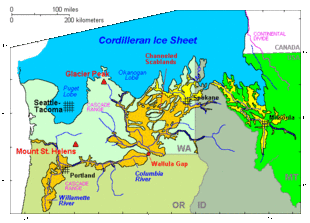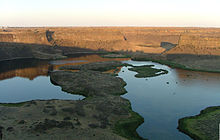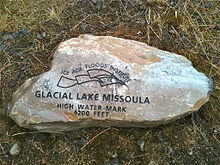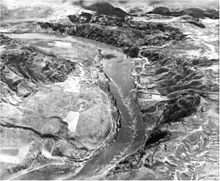Introduction and References of first report (DocumentCloud)
Rebuilding Interior Columbia Basin Salmon and Steelhead
Regional Fishery Co-manager Review Draft
v2.5 July 11, 2022
Introduction
Rebuilding salmon and steelhead stocks in the Columbia River Basin to levels that are healthy and harvestable requires careful consideration of the science that informs rebuilding strategies and actions. This document1 provides a high-level response to eight common questions about the science2 surrounding Columbia River basin salmon and steelhead rebuilding efforts. The questions and responses are meant to inform the broader discussion around the socio-economic factors and resources necessary to help these species recover.
The scope of this analysis includes the clusters of populations, or stocks, of natural-origin Pacific salmon and steelhead originating above Bonneville Dam (i.e., in the interior Columbia River basin), as well as their life-cycle needs associated with freshwater, estuary, and marine habitats (Figure 1).
(A) (B)
Figure 1. Maps of the Columbia River basin. (A) shows areas a) currently occupied by anadromous salmon and steelhead (light green), b) historically used
by anadromous fish but currently inaccessible due to dams blocking fish passage (dark green), and
c) historically inaccessible due to natural migration barriers (light blue). (B) shows regional areas associated with stock delineations in this report (modified from NMFS 2020).
These stocks are critically important to Columbia River basin tribes, as well as to the economy and overall ecological health of the region. Despite their undisputed value, they have been negatively affected by extensive anthropogenic activity—in particular, the dams and reservoirs that form the Columbia River
1 This draft report was prepared by the National Oceanic and Atmospheric Administration, with input from and support of the U.S. Fish and Wildlife Service and input from scientists and fishery managers from the Nez Perce Tribe and State of Oregon. The draft will be circulated to state and Tribal co-managers for input before being finalized. Whenever possible, responses are informed by NMFS (2020), Phase 2 Report of the Columbia Basin Partnership Task Force of the Marine Fisheries Advisory Committee.
2 Does not consider socioeconomic or political science.
System3 (CRS; NAS 1996). The CRS has been the subject of decades of litigation regarding the effects on salmon and steelhead and modifications to their stream, river, floodplain, and estuary habitats. In addition, and as identified in the ESA Recovery Plans (NOAA 2017, UCSRB & NMFS 2007) as factors for listing and key areas of concern for recovery actions, historic and ongoing degradation of stream, river, floodplain, and estuary habitats severely limit the biological potential of all interior Columbia River basin stocks.
The goals of this analysis are to inform achieving the mid-range Columbia Basin Partnership (CBP)4
Task Force’s naturally produced adult salmon and steelhead abundance goals by 2050, and, by 2030, the Northwest Power and Conservation Council’s (NPCC 2020) productivity goals, as measured by smolt-to- adult return rates (SARs). These goals are commonly understood and referenced by fish managers and the public because of the transparent public processes used to establish them; they are reasonable quantitative targets that we embrace for the purposes of this analysis. Mid-range abundance goals exceed ESA recovery thresholds for abundance, and represent progress toward healthy and harvestable status of these stocks (NMFS 2020). The CBP low-, mid-, and high-range quantitative goals are all substantially greater than the ESA Section 7(a)(2) conservation standard of not likely jeopardizing the continued existence of listed species that is applied to federal agency actions in ESA Section 7(a)(2) consultations.
Achieving these fish-related goals would also provide the highest certainty for meeting multiple objectives that address tribal inequities, securing a pathway to harvestable abundance levels, and meeting ESA needs in the face of climate change (Figure 2).
Figure 2.
Conceptual abundance continuum of salmon and steelhead, aggregated across the 16 stocks (ESA listed and non- listed) upstream
of Bonneville
dam, relative to management thresholds and goals. Mid-range goals exceed ESA recovery abundance thresholds and represent progress toward high-range goals associated with healthy and harvestable status (NMFS 2020).
3 Fourteen federally owned and operated hydroelectric dams (projects) on the Columbia and Snake rivers, including: Libby, Hungry Horse, Albeni Falls, Grand Coulee, Chief Joseph, Dworshak, Lower Granite, Little Goose, Lower Monumental, Ice Harbor, McNary, John Day, The Dalles, and Bonneville.
4 NOAA Fisheries and its Marine Fisheries Advisory Committee (MAFAC) convened the CBP Task Force in 2017, bringing together diverse representatives from across the Columbia River basin to a) establish a common vision and goals for the basin and its salmon and steelhead (NMFS 2020), and b) establish urgency to achieve the agreed-upon high-range goals.
2
The criteria for species and area priorities include: 1) level of extinction risk, 2) current spatial structure and diversity, 3) importance to tribal communities, 4) habitats essential for life-cycle needs, and 5) resilience of habitat to climate change. Although they in no way reduce the importance of all extant and extirpated Columbia Basin native salmon and steelhead, the criteria allow for a broad-level analysis that helps provide a draft context for sequencing and prioritizing multifaceted, long-term, and complex rebuilding actions.
Bibliography:
Alden, W.C. 1953. Physiography and Glacial Geology of Western Montana and Adjacent Areas. US Geological Survey Professional Paper 231. 200 pp.
Anderson, N.L., Paszkowski, C.A., & G.A. Hood. 2015. Linking aquatic and terrestrial environments: can beaver canals serve as movement corridors for pond-breeding amphibians? Animal Conservation, 18, 287-294.
Barrows, M.G., Anglin, D.R., Sankovich, P.M., Hudson, J.M., Koch, R.C., Skalicky, J.J., Wills, D.A., & B.P. Silver. 2016. Use of the Mainstem Columbia and Lower Snake Rivers by Migratory Bull Trout: Data Synthesis and Analyses, Final Report. Vancouver, WA: U.S. Fish and Wildlife Service (USFWS).
Bellmore, J.R., & C.V. Baxter. 2014. Effects of Geomorphic Process Domains on River Ecosystems: A Comparison of Floodplain and Confined Valley Segments. River Research and Applications, 30(5), 617-630.
Bouwes, N., Weber, N., Jordan, C.E., Saunders W.C., Tattam, I.A., Volk, C., Wheaton, J.M., & M.M. Pollock. 2016. Ecosystem experiment reveals benefits of natural and simulated beaver dams to a threatened population of steelhead (Oncorhynchus mykiss). Sci. Rep. 6, 28581; doi: 10.1038/ srep28581.
Bowerman, T., Keefer, M.L., & C.C. Caudill. 2021. Elevated stream temperature, origin, and individual size influence Chinook salmon prespawn mortality across the Columbia River Basin. Fisheries Research 237:105874.
Brenkman, S.J., Peters, R.J., Tabor, R.A., Geffre, J.J., & K.T. Sutton. 2019. Rapid recolonization and life history responses of Bull Trout following dam removal in Washington’s Elwha River. North American Journal of Fisheries Management 39:560–573.
Bryson, G. E., Kidd, K. A., & K.M. Samways. 2022. Food web incorporation of marine-derived nutrients after the reintroduction of endangered inner Bay of Fundy Atlantic salmon (Salmo salar). Canadian Journal of Fisheries and Aquatic Sciences, 99(999), 1-8.
Caudill, C.C., Keefer, M.L., Clabough, T.S., Naughton, G.P., Burke, B.J., & C.A. Peery. 2013. Indirect effects of impoundment on migrating fish: temperature gradients in fish ladders slow dam passage by adult Chinook Salmon and steelhead. PLoS ONE 8:e85586. DOI: 10.1371/journal.pone.0085586. Fagan, W.F., Holmes, E.E., 2006. Quantifying the extinction vortex. Ecology Letters 9:51–60.
CBC (Columbia Basin Collaborative). 2020. Agreement between the states of Oregon, Washington, Idaho and Montana to define a future collaborative framework to analyze and discuss key issues related to salmon and steelhead with the purpose of increasing overall abundance. https://species.idaho.gov/ wp-content/uploads/2021/02/Four-State-Agreement-Columbia-River-Salmon-10-01-20.pdf.
CEQ (Council of Environmental Quality). 2022. White House Blog March 28, 2022. https://www. Columbia River Basin Fisheries: Working Together to Develop a Path Forward | The White House develop-a-path-forward/#_ftn2.
Crozier, L. G., Hendry, A.P., Lawson, P.W., Quinn, T.P., Mantua, N.J., Battin, J., Shaw, R.G., & R.B. Huey. 2008. Potential responses to climate change in organisms with complex life histories: evolution and plasticity in Pacific salmon. Evolutionary Applications 1:252-270.
Crozier, L.G., McClure, M.M., Beechie, T., Bograd, S.J., Boughton, D.A., Carr, M., Cooney, T.D., Dunham, J.B., Greene, C.M., Haltuch, M.A., Hazen, E.L., Holzer, D.M., Huff, D.D., Johnson, R.C., Jordan, C.E., Kaplan, I.C., Lindley, S.T., Mantua, N.J., Moyle, P.B., Myers, J.M., Nelson, M.W., Spence, B.C., Weitkamp, L.A., Williams, T.H., & E. Willis-Norton. 2019. Climate vulnerability assessment for Pacific salmon and steelhead in the California Current Large Marine Ecosystem: PLoS ONE, https://doi.org/10.1371/journal.pone.0217711.
21
Crozier, L.G., Siegel J.E., Wiesebron, L.E., Trujillo, E.M., Burke, B.J., Sandford, B.P., & D. L. Widener. 2020. Snake River sockeye and Chinook salmon in a changing climate: Implications for upstream migration survival during recent extreme and future climates. PLoS ONE 15(9): e0238886. https:// Snake River sockeye and Chinook salmon in a changing climate: Implications for upstream migration survival during recent extreme and future climates.
Crozier, L.G., Burke, B.J., Chasco, B.E., Widener, D.L., & R.W. Zabel. 2021. Climate change threatens Chinook salmon throughout their life cycle. Available at: https://www.nature.com/articles/s42003- 021-01734-w.pdf.
EPA (Environmental Protection Agency). 2020a. Columbia and Lower Snake Rivers Temperature Total Maximum Daily Load. U.S. Environmental Protection Agency, Seattle, WA. May 2020. Available at TMDL for Temperature in the Columbia and Lower Snake Rivers | US EPA.
EPA (Environmental Protection Agency). 2020b. Assessment of Impacts to Columbia and Snake River Temperatures using the RBM10 Model Scenario Report: Appendix D to the Columbia and Lower Snake Rivers Temperature Total Maximum Daily Load. U.S. Environmental Protection Agency, Seattle, WA. May 2020. Available at TMDL for Temperature in the Columbia and Lower Snake Rivers | US EPA.
EPA (Environmental Protection Agency). 2021. Columbia River Cold Water Refuges Plan. U.S. Environmental Protection Agency, Seattle, WA. January 2021. Available at https://www.epa.gov/ columbiariver/columbia-river-cold-water-refuges-plan.
Fagan, W.F., & E.E. Holmes. 2006. Quantifying the extinction vortex. Ecology Letters, 9:51-60.
Fish, F., & M. Hanavan. 1948. A report upon the Grand Coulee fish-maintenance project 1939-1947. Special Scientific Report No. 55, U.S. Fish and Wildlife Service, Washington, D.C.
Ford, M. J., editor. 2022. Biological Viability Assessment Update for Pacific Salmon and Steelhead Listed Under the Endangered Species Act: Pacific Northwest. U.S. Department of Commerce, NOAA Technical Memorandum NMFS-NWFSC-171. Biological Viability Assessment Update for Pacific Salmon and Steelhead Listed Under the Endangered Species Act: Pacific Northwest.
Francis, T.B., Schindler, D.E., & J.M. Moore. 2006. Aquatic insects play a minor role in dispersing salmon-derived nutrients into riparian forests in southwestern Alaska. Canadian Journal of Fisheries and Aquatic Sciences, 63(11), 2543-2552.
Gende, S.M., Edwards, R.T., Willson, M.F., & M.S. Wipfli. 2002. Pacific salmon in aquatic and terrestrial ecosystems: Pacific salmon subsidize freshwater and terrestrial ecosystems through several pathways, which generates unique management and conservation issues but also provides valuable research opportunities. BioScience, 52(10), 917-928.
Gilpin, M.E., & M.E. Soulé. 1986. Minimum viable populations: processes of species extinction. Pages 19–34 in Soulé, M.E. (Ed.), Conservation Biology: The Science of Scarcity and Diversity. Sinauer, Sunderland, MA.
ISAB (Independent Scientific Advisory Board), 2007. Climate change impacts on Columbia River basin fish and wildlife. https://www.nwcouncil.org/sites/default/files/isab2007_2.pdf.
Isaak, D.J., Luce, C.H., Horan, D.L., Chandler, G.L., Wollrab, S.P., & D.E. Nagel. 2018. Global warming of salmon and trout rivers in the northwestern U.S.: road to ruin or path through purgatory? Transactions of the American Fisheries Society 147:566–587.
Jordan, C.E. & E. Fairfax. (2022) Beaver: the North American freshwater climate action plan. Wiley Interdisciplinary Reviews Water, 1–13. https://doi.org/10.1002/wat2.1592
Jorgensen, J.C., Nicol C., Fogel C., & T.J. Beechie. 2021. Identifying the potential of anadromous salmonid habitat restoration with life cycle models. PLoS ONE 16(9): e0256792.
Kocik, J. F., Hayes, S. A., Carlson, S. M. & B. Cluer. (2022). A Resist-Accept-Direct (RAD) future for Salmon in Maine and California: Salmon at the southern edge. Fisheries Management and Ecology, 00, 1–19. https://doi.org/10.1111/fme.12575
22
Mathewson, D.D., Hocking, M.D., & T.E. Reimchen. 2003. Nitrogen uptake in riparian plant communities across a sharp ecological boundary of salmon density. BMC ecology, 3(1), 1-11.
McCann, J., Chockley, B., Cooper, E., Hsu, B., Haeseker, S., Lessard, R., Petrosky, C., Copeland, T., Tinus, E., Storch, A., & D. Rawding. 2018. Comparative survival study (CSS) of PIT-tagged spring/ summer/fall Chinook, summer steelhead and Sockeye. Annual Report to the Bonneville Power Administration, Contract 19960200, Portland, OR. https://www.fpc.org/documents/CSS/2018-CSS- Report-Fix.pdf.
McElhany, P., Rucklelshaus, M., Ford, M., Wainwright, T., & E. Bjorkstedt. 2000. Viable salmonid populations and the recovery of evolutionarily significant units. Northwest Fisheries Science Center, NOAA Technical Memorandum NMFS-NWFSC-42. Viable salmonid populations and the recovery of evolutionarily significant units.
National Academy of Sciences (NAS). 1996. Upstream: Salmon and Society in the Pacific Northwest. National Academy Press, Washington D.C.
NMFS (National Marine Fisheries Service). 2020. A vision for salmon and steelhead: goals to restore thriving salmon and steelhead to the Columbia River basin. Phase 2 report of the Columbia
River Partnership Task Force of the Marine Fisheries Advisory Committee. Portland, OR. https:// s3.amazonaws.com/media.fisheries.noaa.gov/2020-10/MAFAC_CRB_Phase2ReportFinal_508.pdf?null.
NOAA (National Oceanic and Atmospheric Administration). 2017. ESA Snake River Fall Chinook Salmon Recovery Plan. Portland, OR. https://media.fisheries.noaa.gov/dam-migration/final-snake- river-fall-chinook-salmon-recovery-plan-2017.pdf.
NOAA (National Oceanic and Atmospheric Administration). 2022. Ocean Conditions Indicators Trends web page. Ocean Conditions Indicators Trends | NOAA Fisheries.
NPCC (Northwest Power and Conservation Council). 2020. Columbia River Basin Fish and Wildlife Program 2014: The 2020 Addendum. NPCC Report 2020-9. Available by download from: https:// 2020 Addendum to the 2014 Columbia River Basin Fish and Wildlife Program.
Nummi, P., Liao, W., van der Schoor, J., & J. Loehr. 2021. Beaver creates early successional hotspots for water beetles. Biodiversity and Conservation, 30(10), 2655-2670.
ODFW (Oregon Department of Fish and Wildlife). 2020. Coastal, Columbia, and Snake conservation plan for lampreys in Oregon: Pacific Lamprey, Western River Lamprey, Western Brook Lamprey, and Pacific Brook Lamprey. https://www.dfw.state.or.us/ fish/CRP/coastal_columbia_snake_lamprey_ plan.asp.
Petrosky, C.E., Schaller, H.A., Tinus, E.S., Copeland, T., & A.J. Storch. 2020. Achieving productivity to recover and restore Columbia River stream‐type Chinook Salmon relies on increasing smolt‐to‐adult survival. North American Journal of Fisheries Management 40:789–803.
Philip, S.Y., Kew, S.F., van Oldenborgh, G.J., Anslow, F.S., Seneviratne, S.I., Vautard, R., Coumou, D., Ebi, K.L., Arrighi, J., Singh, R., van Aalst, M., Pereira Marghidan, C., Wehner, M., Yang, W., Li, S., Schumacher, D.L., Hauser, M., Bonnet, R., Luu, L.N., Lehner, F., Gillett, N., Tradowsky, J., Vecchi, G.A., Rodell, C., Stull, R.B., Howard, R., & F.E.L. Otto. 2021. Rapid attribution analysis of the extraordinary heatwave on the Pacific Coast of the US and Canada. Earth Syst. Dynam. DOI: 10.5194/esd-2021-90.
Scott, M.H. 2020. Statistical Modeling of Historical Daily Water Temperatures in the Lower Columbia River. 2020. Dissertations and Theses. Paper 5594."Statistical Modeling of Historical Daily Water Temperatures in the Low" by Malia Hanae Scott
Simberloff, D. 1988. The contribution of population and community biology to conservation science. Annual Review of Ecological Systems 19:473–511.
Skidmore, P., & J.M. Wheaton. 2022. Natural infrastructure—Can restored riverscapes help us adapt to climate change. Anthropocene. https://doi.org/10.13140/RG.2.2.33525.86248.
23
Storch, A.J., H.A. Schaller, C.E. Petrosky, R.L. Vadas, B.J. Clemens, G. Sprague, N. Mercado-
Silva, B. Roper, M.J. Parsley, E. Bowles, R.M. Hughes, & J.A. Hesse. 2022. A review of
potential conservation and fisheries benefits of breaching four dams in the Lower Snake River (Washington, USA). Water Biology and Security. 100030, ISSN 2772-7351, https://doi.org/10.1016/j. watbs.2022.100030. (A review of potential conservation and fisheries benefits of breaching four dams in the Lower Snake River (Washington, USA) - ScienceDirect).
Tonina, D., McKean, J. A., Isaak, D.,Benjankar, R. M., Tang, C., & Q. Chen. (2022). Climate change shrinks and fragments salmon habitats in a snow dependent region. Geophysical Research Letters, 49, e2022GL098552. https://doi.org/10.1029/2022GL098552
Tonra, C.M., Sager-Fradkin, K., Morley, S.A., Duda, J.J., & P.P. Marra. 2015. The rapid return of marine- derived nutrients to a freshwater food web following dam removal. Biological Conservation, 192, 130-134.
UCSRB & NMFS (Upper Columbia Salmon Recovery Board, National Marine Fisheries Service). 2007. Upper Columbia Spring Chinook Salmon and Steelhead Recovery Plan https://repository.library. noaa.gov/view/noaa/15990
UCUT (Upper Columbia United Tribes). 2019. Fish passage and reintroduction Phase 1 Report: Investigations upstream of Chief Joseph and Grand Coulee dams. Upper Columbia United Tribes, Spokane, WA. 154 p.
USFWS (U. S. Fish and Wildlife Service). 1999. Recovery Plan for the White Sturgeon (Acipenser transmontanus): Kootenai River Population. U.S. Fish and Wildlife Service, Portland, OR. 96 pp. plus appendices.
USFWS (U. S. Fish and Wildlife Service). 2015. Recovery Plan for the Coterminous United States Population of Bull Trout (Salvelinus confluentus). Portland, OR. Pacific | U.S. Fish & Wildlife Service bulltrout/pdf/Final_Bull_Trout_Recovery_Plan_092915.pdf.
Williams, B.K., Szaro, R.C., & C.D. Shapiro. 2009. Adaptive Management: The U.S. Department of the Interior Technical Guide. Adaptive Management Working Group, U.S. Department of the Interior, Washington, DC. ISBN:978-1-4133-2478-7.
Wohl, E., Lininger, K.B., & D.N. Scott. 2017. River beads as a conceptual framework for building carbon storage and resilience to extreme climate events into river management. Biogeochemistry, 141(3), 365–383.
Wohl, E., Castro, J., Cluer, B., Merritts, D., Powers, P., Staab, B., & C. Thorne. 2021. Rediscovering, reevaluating, and restoring lost river-wetland corridors. Frontiers in Earth Science, 9, 511.
Zabel, R.W. & C.E. Jordan (eds). 2020. Life Cycle Models of Interior Columbia River Basin Spring/ Summer-Run Chinook Salmon Populations. U.S. Dept. Commer. NOAA Tech. Memo. NMFS- NWFSC-156. Life Cycle Models of Interior Columbia River Basin Spring/Summer-Run Chinook Salmon Populations.

